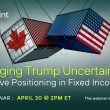by Erik L. Knutzen, CFA, CAIA, Chief Investment Officer—Multi-Asset, Neuberger Berman
“What I write here on Friday could be out-of-date by the time you are reading it on Monday,” said Joe Amato, in last week’s commentary on the rise in political volatility.
The next day, his point was underlined in the most shocking way in Butler, Pennsylvania, with the attempted assassination of Republican presidential candidate Donald Trump. A week later, we have had another weekend surprise in the U.S. election, with President Joe Biden announcing that he would step aside and endorse Vice President Kamala Harris as the new Democratic candidate. While it is too soon to assess the implications of the latest developments, the uncertainty around the current situation is, in many ways, consistent with key themes we have been articulating so far this year.
In last week’s blog, Joe Amato also wrote about how the unpredictability of the political scene might be a paradoxical cause of the current low market volatility. We had already warned that volatility seemed unsustainably muted, and that investors should prepare for it to rise as the U.S. election came closer.
Indeed, the past two weeks have seen some extraordinary market moves. Might they be explained by recent softer inflation readings and expectations for more rate cuts, or were investors positioning for a clearer election outcome? Are markets responding to fundamentals or are we seeing the “Trump trade”?
Historic Rotation
Since July 11, while the Nasdaq 100 Index, which is dominated by mega-cap technology stocks, has declined by some 5%, the small- and mid-cap Russell 2000 Index has soared by more than 7%. The broader large-cap Russell 1000 Index is flat.
The scale and rapidity of this rotation into smaller companies has been historic: Out of almost 11,500 discrete 10-day trading periods since 1979, the sessions up to July 18, 2024 saw the third highest outperformance of the Russell 2000 Index over the Russell 1000 Index, exceeded only by two periods during the dotcom boom.
There has also been a significant, if less pronounced, rotation out of Russell 1000 Growth and into Russell 1000 Value companies.
We have been calling for a broadening of corporate earnings and stock market performance beyond U.S. mega-cap tech and the “Magnificent Seven” for some time—in CIO Weekly Perspectives, in Asset Allocation Committee Outlooks (including our latest) and elsewhere.
It would, in our view, be a natural consequence of a soft landing: declining inflation and policy rates combining with resilient economic growth and a steady jobs market. Lower rates would help the “have nots” among corporations and consumers. We believe their interest payments and tighter purse strings pose the greatest current risk to the economy. Lower-income consumers could get a confidence boost from a recovery in their real disposable incomes as inflation eases.
These recent market moves have not materialized exactly as we anticipated, however. We have been emphasizing the importance of quality in a small-cap universe overpopulated with lossmaking companies, and while quality small caps have rallied, this rotation has been led by some lower-quality segments. The suddenness and scale of the move have been remarkable, too. But perhaps both these phenomena are unsurprising given the technical forces, such as short covering, unleashed by the unwinding of one of the most overstretched momentum trades in history.
Catalyst
Is the change in market leadership due to expectations for a change in U.S. political leadership? In our view, while some evidence supports the idea of a “Trump-trade,” the case is not definitive.
Both Joe Amato last week, and Tim Creedon and Raheel Siddiqui before him, have written about Trump’s policies on taxes, regulation, immigration and trade.
On taxes and regulation, Trump’s platform is the more obviously pro-business and pro-market. One could point to the outperformance of Financials and Energy in this recent rotation, for example, and identify them as being particularly exposed to a change in the regulatory environment. On the other hand, they were also among the most unloved sectors during the long months of mega-cap tech outperformance and yield-curve inversion, so the scale of current moves may be attributable largely to technical forces.
Moreover, the rotation in equity markets, which sparked into life on July 11, predates the attack on Trump. And while Joe Biden’s shaky performance in the televised debate on June 27 may have started to shift opinion polls in Trump’s favor, it does not appear to have been a major factor in the markets, though Biden’s announcement this weekend may be.
July 11 offers us a much more obvious catalyst: It was the day of the latest, unexpectedly benign U.S. inflation release. As well as putting fuel under small caps and value stocks, it convinced rates markets to price more decisively for two or even more cuts from the Federal Reserve this year.
If the current equity market rotation is mainly about declining inflation, that raises major questions about it being a Trump trade: His tax, immigration and trade policies are all potentially inflationary.
Too Soon to Call
Some of the recent equity moves may have been due to investors positioning for a clearer election outcome, but a straight line in the current direction seems very unlikely. We believe it is too soon to make any assumptions about the election outcome: given the events of the weekend, investors (and voters) will need to gain clarity on the candidates, their platform, and their prospects for winning. Even if polls continue to tilt in Trump’s favor, we may see a consequent pricing for the return of inflation risk. And finally, moves of this magnitude, even if they ultimately persist, tend to be subject to sharp, technical pullbacks. For all the reasons we cite above, we continue to anticipate rising market volatility as the vote gets nearer.
*****
In Case You Missed It
- China Q2 GDP: +4.7% year-over-year
- U.S. Retail Sales: flat at 0.0% month-over-month in June
- NAHB Housing Market Index: -1.0 to 42.0 in July
- U.S. Building Permits: +3.4% to SAAR of 1.45 million units in June
- U.S. Housing Starts: +3.0% to SAAR of 1.35 million units in June
- European Central Bank Policy Meeting: The ECB made no changes to its policy stance
- Japan Consumer Price Index: National CPI rose +2.8% year-over-year and Core CPI rose +2.6% year-over-year in June
What to Watch For
-
- Tuesday, July 23:
- Eurozone Consumer Confidence Indicator (Flash)
- U.S. Existing Home Sales
- Japan Manufacturing Purchasing Managers’ Index (Preliminary)
- Wednesday, July 24:
- Eurozone Manufacturing Purchasing Managers’ Index (Preliminary)
- U.S. New Home Sales
- Thursday, July 25:
- U.S. Durable Goods Orders
- U.S. Q2 GDP (First Preliminary)
- Friday, July 26:
- U.S. Personal Income and Outlays
- Tuesday, July 23:
Investment Strategy Team
Copyright © Neuberger Berman















